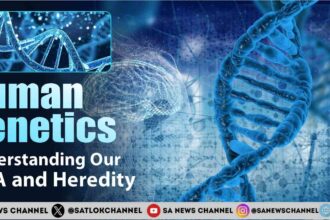The human genome, often referred to as the “blueprint of life,” is a complex and intricate tapestry woven from around 3.2 billion DNA base pairs. This genomic sequence not only defines our biological identity but also holds the key to understanding our health, ancestry, and evolution. Since the completion of the Human Genome Project in 2003, scientists have commenced an exhilarating journey to decode the mysteries hidden within our genetic make-up.
- The Human Genome: Defining Human Genome
- The Human Genome: Structural Organization of the Human Genome
- The Human Genome: Protein-Coding Genes and Non-Coding DNA
- The Human Genome: The Significance of Mitochondrial DNA
- The Human Genome: Genetic Variations
- The Human Genome: Unlocking the Blueprint of Life: The Human Genome Project
- The Human Genome: Satlok is the place of boundless happiness
- The Human Genome: FAQs
- Question: How many base pairs are present in the human genome?
- Question: What was the duration of the Human Genome Project?
- Question: Which is the place of limitless happiness?
- Question: Who is providing the true way of worship?
- Connect With Us on the Following Social Media Platforms
As we dive deep into the world of genomics, we discover not just the similarities that bind us as a species, but also the unique variations that shape our individual traits. Join us as we explore the profound implications of genomic research and its potential to revolutionize medicine, enhance our understanding of human diversity, and unlock new frontiers in health care.
The Human Genome: Defining Human Genome
The human genome is a complete set of genetic instructions found in human DNA, comprising approximately 3 billion base pairs structured into 23 pairs of chromosomes. This contains 20,000 to 25,000 protein-coding genes responsible for producing proteins essential for various biological functions.
■ Also Read: Human DNA: Genetic Material of the Body
In addition, the genome contains a significant amount of non-coding DNA, which plays crucial roles in the regulation of genes and maintenance of genomic integrity.
The Human Genome: Structural Organization of the Human Genome
The structure and organization of the human genome involve complex arrangements of DNA within the cell nucleus, primarily characterized by the nuclear genome and the mitochondrial genome.
Nuclear Genome
The nuclear genome is the genetic material of the cell. The Human Genome consists of approximately 3.1 billion base pairs that make up the human genome. These base pairs are situated across 24 distinct chromosomes (22 autosomes and 2 sex chromosomes, X and Y).
Chromatin is condensed to form chromosomes. Chromatin with the association of histone and non-histone proteins is condensed to form chromosomes.Chromosomes vary in size.
Chromosomal Features
Each chromosome contains specific regions. These are:
- Centromeres: It is a constricted region in the DNA required for the segregation of the chromosome during cell division.
- Telomeres: These are certain DNA sequences which protect the terminals of the chromosomes from damage and degradation.
The human genome contains nearly 1-2% coding DNA, responsible for protein synthesis, while a major portion of the human genome consists of non-coding regions, repetitive sequences, and transposable elements, often referred to as “junk DNA”. These may have regulatory roles.
Mitochondrial Genome
The mitochondrial genome is double stranded and circular. It consists of about 16,500 base pairs. This genome codes for the proteins essential for the functioning of mitochondria. This genome is inherited maternally.
Distribution of the Genes
Genes are unevenly distributed across chromosomes, with regions rich in guanine-cytosine (GC) pairs typically containing a higher density of genes compared to those with lower GC content. There are 20,000 to 25,000 protein-coding genes. Also there are various non-coding RNA genes.
Repetitive Elements
The frequently repeated sequences across the DNA are known as repetitive elements. Approximately over 50% of the human genome contains repetitive sequences.
The structural organization of the human genome is crucial for understanding genetic functions and variations. It influences aspects of health, disease susceptibility, and evolutionary biology, making it a focal point in genomic research and personalized medicine.
The Human Genome: Protein-Coding Genes and Non-Coding DNA
Coding and Non-Coding Sequences are the portions of the human DNA.
- Coding Sequences (CDS): These are the DNA segments that contain sequences for the synthesis of proteins.
- Non-Coding Sequences: These sequences constitute nearly 98-99% of the genome. The non-coding regions include elements required for the regulation of gene expression, such as silencers as well as enhancers. This region also comprises structural components like telomeres and centromeres. Non-coding RNA genes, which consist of microRNAs and long non-coding RNAs, perform the function of regulation of various cellular processes. These are important sequences of the DNA rather than being merely “junk” DNA.
The Human Genome: The Significance of Mitochondrial DNA
Mitochondrial DNA (mtDNA) is a small circular double stranded DNA physically situated within mitochondria. This DNA plays a significant role in energy production in cells. A total of 37 genes are coded by mtDNA. Some of these genes are essential for the production of proteins required for oxidative phosphorylation.
Also mtDNA contains genes for ribosomal RNA (rRNA) and transfer RNA (tRNA), which are essential for protein synthesis within mitochondria. While on one side nuclear DNA is inherited from both the parents, mtDNA is only inherited maternally, i.e, a child receives this mitochondrial DNA from his mother and not father. The mtDNA has a higher mutation rate which makes it important for studies in evolution and disease. Damage to mtDNA can lead to various disorders, selectively affecting high-energy-demand tissues such as the muscles and the nervous system.
The Human Genome: Genetic Variations
Genetic variations in human DNA refers to the differences in nucleotide sequences among individuals. This includes single nucleotide polymorphisms (SNPs), structural variations such as copy number variations (CNVs) as well as insertions/deletions (indels). These variations which arise during DNA replication or due to external factors can affect the functioning of genes and also contribute to phenotypic variations.
These variations significantly affect individuals. These variations influence vulnerability to diseases, outcome to medications, and general health. Having an understanding of these genetic variations, refines our knowledge of human biology and helps in developing personalized medicine approaches.
The Human Genome: Unlocking the Blueprint of Life: The Human Genome Project
The Human Genome Project (HGP) was an international research project. This project was launched in 1990 and completed in 2003. This was a 13 year project. This project was started with an aim to map and sequence the complete human genome, made up of 3.1 billion base pairs. The project determined around 20,000-25,000 genes. This project developed methods for analyzing genetic variations related to diseases.
The HGP was a collaborative approach. It involved a number of scientists from various countries, and emphasized data sharing, making genomic information publicly available.The HGP’s completion has significantly advanced fields like biotechnology and medicine.
The Human Genome: Satlok is the place of boundless happiness
The Earth we are living in, along with the 21 brahmands of kaal is a place of punishment. People living in this kaal lok suffer from 84 lakh births. All the living beings residing in this kaal lok are under the cycle of birth and death. There is no happiness in this kaal lok.
The permanent rescue from this cycle of birth and death can only be attained by achieving salvation. One can go to Satlok after attaining salvation. Satlok is the place of boundless happiness. There are no sorrows in Satlok. The true way of worship to attain salvation is provided by Saint Rampal Ji Maharaj. Readers are requested to read the sacred book ‘Gyan Ganga’ and ‘Way of Living’ by Saint Rampal Ji Maharaj.
The Human Genome: FAQs
Question: How many base pairs are present in the human genome?
Answer: Human genome is made up of 3 billion base pairs.
Question: What was the duration of the Human Genome Project?
Answer: The Human Genome Project started in 1990 and completed in 2003. It was a 13 year project.
Question: Which is the place of limitless happiness?
Answer: Satlok is the place of boundless happiness.
Question: Who is providing the true way of worship?
Answer: Saint Rampal Ji Maharaj is providing the true way of worship to attain salvation.









